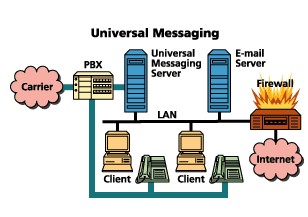|
|
DSC Tech Library
Computer Telephony Integration
 This section of our technical library presents information and documentation relating to CTI Computer Telephony Integration software and products.
Computer Telephony Integration CTI software is a rich set of phone software library routines that enable application programs to control your phone system.
This comprehensive CTI software lets you increase employee productivity, enhance customer service and reduce costs by combining the capabilities of our PACER phone system with the custom functionality of your Windows, Unix or Web applications.
Data collected by your phone ACD (Automatic Call Distribution) or IVR (Interactive Voice Response) systems can be passed to your existing PC, Unix or Web applications through our phone software.
The PACER predictive dialer can automatically call your customers and pass only connected calls to your agents. With our computer telephony software, your telephone and computer work together to provide cost-saving benefits.
This section of our technical library presents information and documentation relating to CTI Computer Telephony Integration software and products.
Computer Telephony Integration CTI software is a rich set of phone software library routines that enable application programs to control your phone system.
This comprehensive CTI software lets you increase employee productivity, enhance customer service and reduce costs by combining the capabilities of our PACER phone system with the custom functionality of your Windows, Unix or Web applications.
Data collected by your phone ACD (Automatic Call Distribution) or IVR (Interactive Voice Response) systems can be passed to your existing PC, Unix or Web applications through our phone software.
The PACER predictive dialer can automatically call your customers and pass only connected calls to your agents. With our computer telephony software, your telephone and computer work together to provide cost-saving benefits.
Computer Telephony for the Enterprise
Page 3
By Michael Sampson
There are user benefits also, such as the availability of detailed audit records. Users of the more advanced e-mail packages--Novell GroupWise, for example--demonstrate a reliance on Outbox tracking as a normal part of daily communications. Integrated messaging extends this audit trail to all forms of store and forward communication tasks, rather than just e-mail.
 Integrated messaging for your organization will mean servers running universal messaging server software, and revamped client software for each end user. An alternative is to sign up for a carrier network-based service, such as networkMCI Contact from MCI Communications.
Integrated messaging for your organization will mean servers running universal messaging server software, and revamped client software for each end user. An alternative is to sign up for a carrier network-based service, such as networkMCI Contact from MCI Communications.
Delivering on the benefits of integrated messaging requires careful network planning and design. Consider the following items when planning towards an implementation:
- Integrate from key messaging asset: The accepted industry wisdom is to integrate from your company's most imp ortant messaging service. In other words, if 80 percent of your company centralises its non-real-time communication around voice mail, the voice mail system becomes the key asset into which the other non-real-time services need to integrate. For example, for those in this category using Octel voice mail equipment, Microsoft Exchange Server for e-mail is a wise choice given the effort Octel has invested in developing the Octel Unified Messenger. Alternatively, if your company is e-mail-centric, start from there and graft in the other services. For example, Lotus Domino sites should investigate the Lotus Telephony OneStop solution.
- Total cost of ownership factors: One focus for 1997 was the principle of total cost of ownership (TCO). Concisely stated, TCO encourages the consideration of the life-cycle cost of infrastructural investments, rather than just start of life costs. Integrated messaging is no different! The key issues to consider include whether the proposed solution will integrate with your directory service (as CallWare Technologies CallWare 5.2 does with Novell Directory Services) for administration and management and your network management tools. Also, minimize client requirements--the proposed solution should use a single client for all message types (vendor solutions that provide one client for voice and fax messages and use a tool bar button to switch to the e-mail client are unsatisfactory), and preferrably use existing services within your desktop operating system.
- PBX and network integration: Does the proposed solution integrate with your PBX infrastructure or will you require an upgrade or a total change? Is the integration accomplished via an open standard, such as TAPI or TSAPI, or through a proprietary interface? Open standards are more future-proof, but proprietary is tighter and cleaner. If a proprietary interface, is the integration analog or digital? Digital is more functional. For organizations running a heterogeneous server infrastructure, will the proposed solution fit with all server platforms? Or can the proposed solution be architectured to run on a single server class within the diverse network? Octel's voice mail services were particularly successful because of the engineering effort Octel invested in tight PBX integration.
- Back-end scalability: How scalable is the back-end storage engine? This is particularly important for the storage of voice media. Sites integrating into Microsoft Exchange Server will need to move towards Exchange Server 5.5, if for nothing else but to get access to the 16-TB storage capabilities. Exchange 5.0 and earlier were limited by a 16-GB storage engine. From an architectural perspective, Oracle InterOffice 4.1 is one of the nicer products because it uses the Oracle database engine for storage rather than a separate mail-only engine.
- Message retention: Consider how to extend your documented e-mail retention policy to all message types.
- Streaming media: Voice message playback through a LAN-connected computer is most seamless when the media is streamed to the client, rather than downloaded and then played. Ensure the appropriate network infrastructure is in place to handle streamed voice and that you are able to assign a higher priority to such time-sensitive network traffic. For users accessing their mailbox from a Web browser outside the firewall, streamed media is again the most appropriate delivery mechanism. Ensure your proposed solution can intelligently deliver voice objects to a Web browser using common streaming protocols (such as RealNetworks RealAudio).
- Multiple client interfaces: Consider the main client interface requirements of your users--the computer, the telephone and the browser. What level of functionality is available through the telephone interface? Is the interface intuitive and friendly? Is access provided to all messages, or just a subset? (For example, fax messages can not be accessed through the phone with Octel Unified Messenger 1.0.) What is the archit ecture of the Web browser interface--does the proposed solution provide its own Web server engine, or can previously deployed services be leveraged?
- Everything else still applies: The previous LAN Messaging Chapter in this Network Design Manual proposes many important questions for e-mail system design. Those questions and issues still apply!
The final key is to deploy with an eye to the future. Prepare for when all communication tasks--real time and non-real time--will be centered around the computer. Voice and video call placement and reception should eventually be integrated into integrated messaging systems.
Page
[1]
[2]
[3]
[4]
[5]
[6]
[7]
[8]
[9]
Next
|


 This section of our technical library presents information and documentation relating to CTI Computer Telephony Integration software and products.
Computer Telephony Integration CTI software is a rich set of phone software library routines that enable application programs to control your phone system.
This comprehensive CTI software lets you increase employee productivity, enhance customer service and reduce costs by combining the capabilities of our PACER phone system with the custom functionality of your Windows, Unix or Web applications.
Data collected by your phone ACD (Automatic Call Distribution) or IVR (Interactive Voice Response) systems can be passed to your existing PC, Unix or Web applications through our phone software.
The PACER predictive dialer can automatically call your customers and pass only connected calls to your agents. With our computer telephony software, your telephone and computer work together to provide cost-saving benefits.
This section of our technical library presents information and documentation relating to CTI Computer Telephony Integration software and products.
Computer Telephony Integration CTI software is a rich set of phone software library routines that enable application programs to control your phone system.
This comprehensive CTI software lets you increase employee productivity, enhance customer service and reduce costs by combining the capabilities of our PACER phone system with the custom functionality of your Windows, Unix or Web applications.
Data collected by your phone ACD (Automatic Call Distribution) or IVR (Interactive Voice Response) systems can be passed to your existing PC, Unix or Web applications through our phone software.
The PACER predictive dialer can automatically call your customers and pass only connected calls to your agents. With our computer telephony software, your telephone and computer work together to provide cost-saving benefits.
 Integrated messaging for your organization will mean servers running universal messaging server software, and revamped client software for each end user. An alternative is to sign up for a carrier network-based service, such as networkMCI Contact from MCI Communications.
Integrated messaging for your organization will mean servers running universal messaging server software, and revamped client software for each end user. An alternative is to sign up for a carrier network-based service, such as networkMCI Contact from MCI Communications.